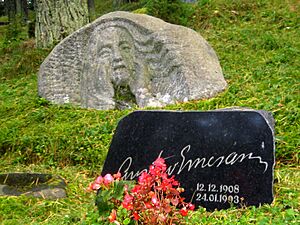Gustav Ernesaks facts for kids
Quick facts for kids
Gustav Ernesaks
|
|
|---|---|
| Born | 12 December 1908 Perila, Harrien County, Governorate of Estonia, Russian Empire
|
| Died | 24 January 1993 (aged 84) |
| Occupation | Composer, conductor |
| Years active | 1930–1993 |
| Spouse(s) | Stella Merjam |
Gustav Ernesaks (born December 12, 1908 – died January 24, 1993) was a very important Estonian composer and a choir conductor. He is remembered for his amazing music and for leading many choirs.
A Life in Music
Gustav Ernesaks was born in Perila, a small place in Estonia. He became a key figure in Estonian music. He helped shape the Estonian Song Festival tradition. This festival brings thousands of singers together. It is a huge event for Estonian culture.
Ernesaks played a big part in the Singing Revolution. This was a peaceful movement. People used singing to show their desire for freedom. It helped Estonia become independent again.
One of his most famous songs is Mu isamaa on minu arm. This means "My Fatherland is My Love." It was based on a poem by Lydia Koidula. This song became like an unofficial national anthem for Estonia. This was during the time when Estonia was part of the Soviet Union.
His performance of this song was very powerful. It even inspired a famous Russian composer, Dmitri Shostakovich. Shostakovich wrote a choral piece called Loyalty. He dedicated it to Ernesaks. Ernesaks also performed this new piece for the first time in Tallinn.
Gustav Ernesaks also composed the official anthem for the Estonian Soviet Socialist Republic. This anthem was used from 1945 to 1990.
In 1935, Ernesaks married Stella Merjam. They had three sons: Ott, Jüri, and Peep. Stella passed away in 1973. Gustav Ernesaks died in Tallinn when he was 84 years old. In 2004, a statue of him was placed at the Tallinn Song Festival Grounds. This honors his lasting legacy.
Awards and Recognition
Gustav Ernesaks received many important awards during his life. These awards recognized his great contributions to music and culture. He was honored both in Estonia and by the Soviet Union.
Some of his top honors included:
- Being named a People's Artist of the USSR. This is a very high title for artists.
- Receiving the Lenin Prize. This was one of the highest awards in the Soviet Union.
- Being given the title of Hero of Socialist Labour. This recognized his hard work and achievements.
These awards show how much his work was valued. He was truly a national hero in Estonia.



